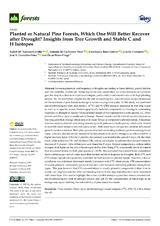Mostrar el registro sencillo del ítem
Planted or Natural Pine Forests, Which One Will Better Recover after Drought? Insights from Tree Growth and Stable C and H Isotopes
| dc.contributor.author | Navarro Cerrillo, Rafael M. | |
| dc.contributor.author | Cachinero-Vivar, Antonio M. | |
| dc.contributor.author | Ruiz Gómez, Francisco | |
| dc.contributor.author | Camarero, J. Julio | |
| dc.contributor.author | González-Pérez, Jose A. | |
| dc.contributor.author | Pérez-Priego, Óscar | |
| dc.date.accessioned | 2023-03-21T10:34:56Z | |
| dc.date.available | 2023-03-21T10:34:56Z | |
| dc.date.issued | 2023 | |
| dc.identifier.uri | http://hdl.handle.net/10396/25038 | |
| dc.description.abstract | Increasing intensity and frequency of droughts are leading to forest dieback, growth decline and tree mortality worldwide. Reducing tree-to-tree competition for water resources is a primary goal for adaptive climate silviculture strategies, particularly in reforested areas with high planting density. Yet, we need better insights into the role of stand type (i.e., natural forests versus plantations) on the resilience of pine forests to droughts across varying time scales. In this study, we combined dendrochronological data and stable C (δ13C) and H (δ2H) isotopes measured in tree-ring wood as well as in specific wood chromatographically isolated compounds to investigate contrasting responses to drought of natural versus planted stands of two representative pine species, i.e., Pinus pinaster and Pinus nigra in southeastern Europe. Natural stands exhibited about two-fold increase in tree-ring growth in average (basal area at 20 years-BAI20) as compared to planted stands. A response function analysis showed contrasting seasonal growth patterns for both species, which were related to monthly mean temperature and precipitation. Both stand type and species variables influenced growth resilience indices. Both pine species revealed contrasting resilience patterns among forest types; whereas planted stands seemed to be less sensitive to yearly droughts as determined by a higher recovery index (CRc) for P. pinaster, the contrary was found in the case of P. nigra. On the other hand, while resistance CRT and resilience CRS indices were higher for planted than natural forests in the case of P. pinaster, little differences were found for P. nigra. Beyond comparisons, carbon stable isotopes shed lights on the role of forest types in dry sites, being δ13C consistently lower in natural than in planted forests for both pine species (p < 0.05). We concluded that planted forest assimilated more carbon as per unit of water used than natural stands in response to droughts. Both δ13C and δ2H isotopic signals were positively correlated for both species for planted forests. However, a lack of correlation was evidenced for natural stands. Consistent with δ13C observations, δ2H concentrations in woody phenolic compounds (guaiacol and oleic acid) revealed contrasting patterns among forest types. This puts forward that δ2H concentrations in woody phenolic compounds (rather than in woody tree ring) accounts for other confounding factors in tree ring formation that can be associated with forest type. Our results highlight the value of stable isotope approaches versus conventional dendrochronological tools in drought studies and call for the consideration of forest type as an endogenous aspect defining the vulnerability of pine forests to climate. | es_ES |
| dc.format.mimetype | application/pdf | es_ES |
| dc.language.iso | eng | es_ES |
| dc.publisher | MDPI | es_ES |
| dc.rights | https://creativecommons.org/licenses/by/4.0/ | es_ES |
| dc.source | Forests, 14(3), 573 (2023) | es_ES |
| dc.subject | Pinus pinaster | es_ES |
| dc.subject | Pinus nigra | es_ES |
| dc.subject | Dendroecology | es_ES |
| dc.subject | Wood isotopes | es_ES |
| dc.subject | δ13C | es_ES |
| dc.subject | δ2H | es_ES |
| dc.subject | Py-CSIA | es_ES |
| dc.subject | Forest die-off | es_ES |
| dc.title | Planted or Natural Pine Forests, Which One Will Better Recover after Drought? Insights from Tree Growth and Stable C and H Isotopes | es_ES |
| dc.type | info:eu-repo/semantics/article | es_ES |
| dc.relation.publisherversion | https://doi.org/10.3390/f14030573 | es_ES |
| dc.rights.accessRights | info:eu-repo/semantics/openAccess | es_ES |

